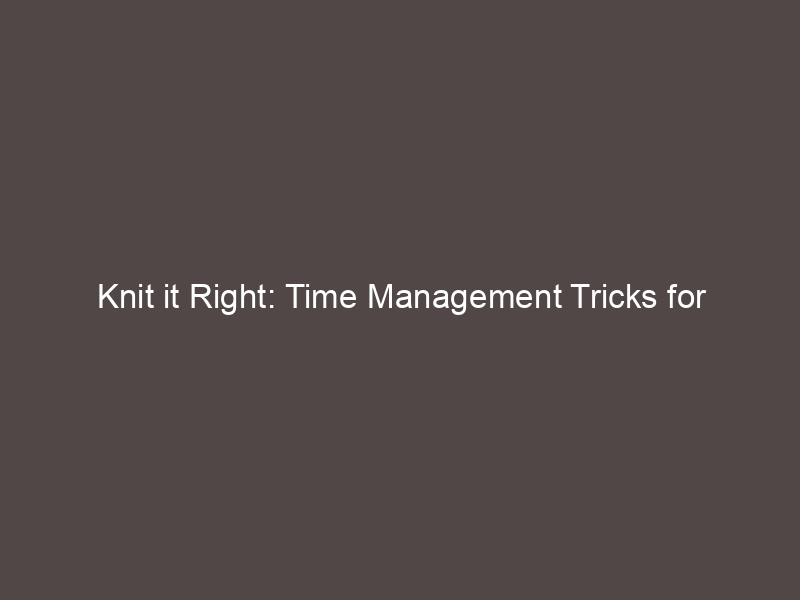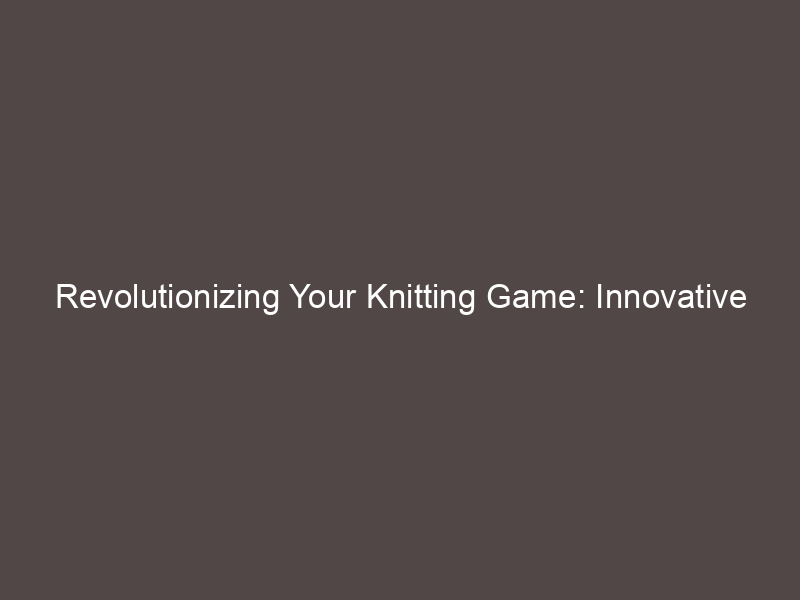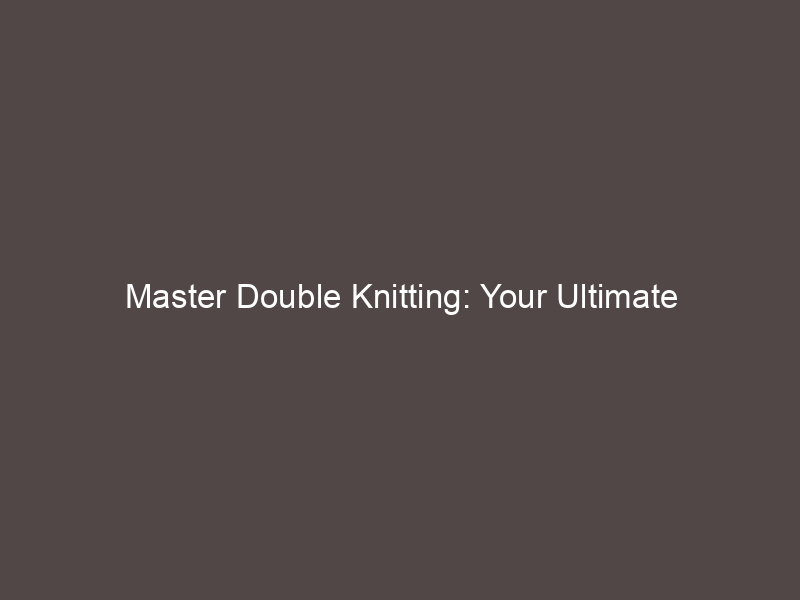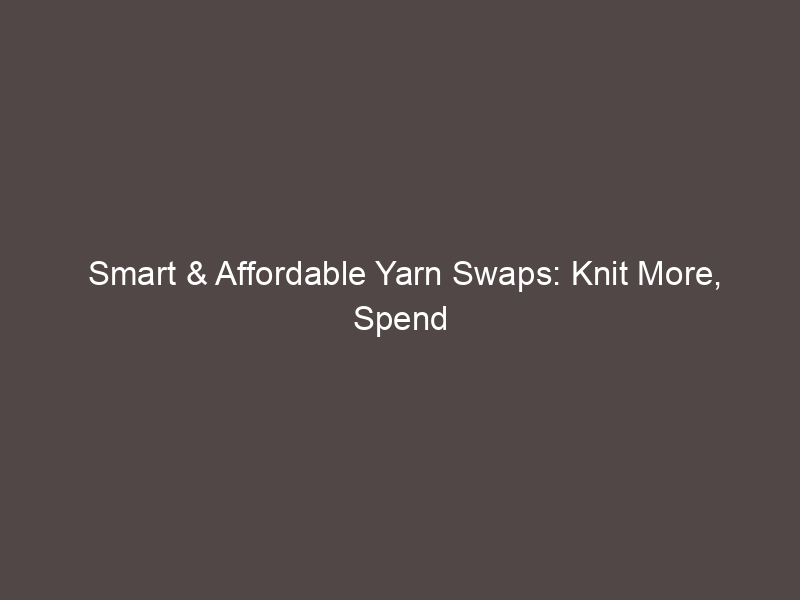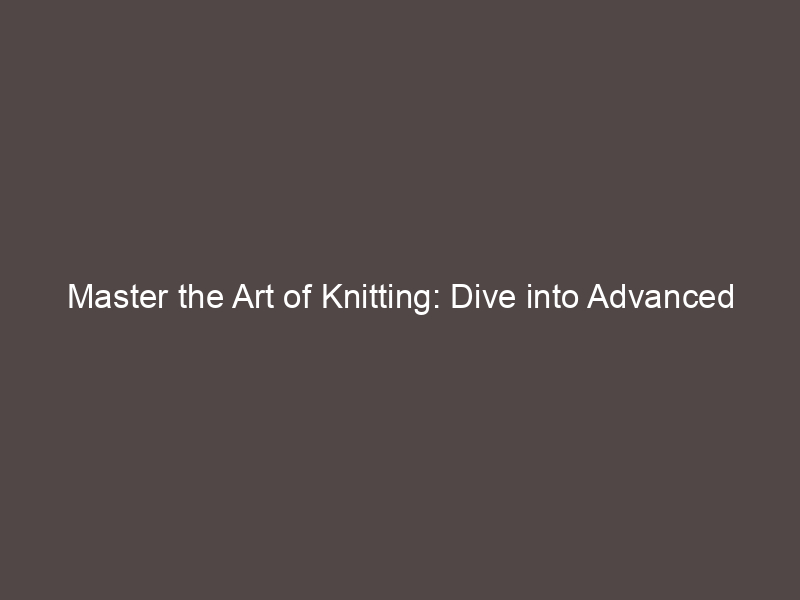
Introduction to Knitting Organization Tips
Knitting is a creative and relaxing hobby that can also be a source of income for many. However, like any other activity, it requires a certain level of organization to ensure efficiency and productivity. In this article, we will explore the importance of staying organized in knitting and the benefits of knitting time management.
- The Importance of Staying Organized in Knitting
- Benefits of Knitting Time Management
Staying organized in knitting is crucial for several reasons. Firstly, it helps you keep track of your projects and the materials you need for each. This way, you won’t lose time searching for a specific yarn or needle. Secondly, an organized knitting space can enhance your creativity. When your materials are neatly arranged, you can easily see your options and get inspired. Lastly, organization can prevent mistakes. For instance, if you have a system to mark where you left off in a pattern, you won’t risk losing your place and making errors.
Time management in knitting can bring about several benefits. One of the main advantages is that it allows you to complete your projects on time. If you’re knitting for business, this can lead to satisfied customers and repeat orders. If you’re knitting as a hobby, it means you can enjoy the fruits of your labor sooner. Additionally, good time management can reduce stress. When you plan your knitting time wisely, you won’t feel rushed or overwhelmed by large projects. Instead, you can enjoy the process of creating something beautiful stitch by stitch.
In the following sections, we will delve deeper into the strategies for effective knitting organization and time management. Whether you’re a beginner or a seasoned knitter, these tips can help you make the most of your knitting time and enhance your enjoyment of this wonderful craft.
Time Management for Knitters
As a knitter, managing your time effectively is crucial to your productivity and the quality of your work. Let’s delve into what time management is and why it’s so important for knitters.
Understanding Time Management
Time management is a skill that everyone can benefit from, especially knitters. But what exactly is it?
- Definition of Time Management
- Why Time Management is Crucial for Knitters
- Efficiency: Good time management allows you to accomplish more in a shorter period, leading to increased productivity.
- Stress Reduction: When you’re not rushing to complete a project, the process of knitting becomes more enjoyable and less stressful.
- Improved Quality: When you’re not pressed for time, you can pay more attention to the details of your work, leading to higher quality knitting projects.
- Meeting Deadlines: If you’re knitting for clients or as gifts, managing your time well ensures that you meet your deadlines without compromising the quality of your work.
Time management is the process of planning and exercising control over the amount of time spent on specific activities. It involves organizing and planning how to divide your time between specific tasks to increase efficiency and productivity.
Time management is particularly important for knitters for several reasons:
In conclusion, time management is a vital skill for knitters. It not only helps you work more efficiently but also makes the process of knitting more enjoyable and less stressful. So, start planning your knitting time today and see the difference it makes!
Practical Tips for Organized Knitting
Knitting is a wonderful hobby that can be both relaxing and productive. However, it can also become overwhelming if you don’t organize your projects properly. Here are some practical tips to help you stay organized and enjoy your knitting even more.
- Planning Your Knitting Projects
- Setting Realistic Knitting Goals
- Using Knitting Tools for Organization
Planning is the first step towards organized knitting. Before you start, have a clear idea of what you want to knit, the pattern you will use, and the yarn required. This will help you avoid starting projects you can’t finish and wasting yarn. A good tip is to keep a knitting journal where you can jot down your project ideas, yarn requirements, and progress.
Setting knitting goals can help you stay focused and motivated. However, it’s important to be realistic about what you can achieve. Consider your skill level, the complexity of the pattern, and the time you can dedicate to knitting. Remember, it’s okay to adjust your goals as you go along. Knitting should be enjoyable, not stressful.
There are many tools available that can help you stay organized. Knitting needle organizers, yarn bowls, and project bags can keep your supplies tidy and easy to find. Stitch markers can help you keep track of your progress in a pattern. Using these tools can make your knitting experience more enjoyable and less frustrating.
In conclusion, staying organized in your knitting can make a big difference in your enjoyment of this hobby. By planning your projects, setting realistic goals, and using organizational tools, you can avoid frustration and make the most of your knitting time.
Staying Organized in Knitting
Staying organized in knitting is not just about keeping your supplies in order, but it also involves managing multiple projects effectively. Let’s delve into the key organizational skills every knitter should have.
Organizational Skills for Knitters
Here are some essential skills that can help you stay organized and efficient in your knitting endeavors:
- Keeping your knitting supplies organized
- Managing multiple knitting projects
Having a well-organized knitting space can make your knitting experience more enjoyable and less stressful. Start by sorting your supplies into categories such as needles, yarns, and patterns. Use containers, baskets, or even ziplock bags to store each category. Label everything clearly so you can easily find what you need when you need it. Remember, a tidy space leads to a tidy mind!
It’s not uncommon for knitters to have multiple projects going on at once. To manage this, create a project list and prioritize them based on deadlines, complexity, and your interest level. Keep each project in a separate bag or box with all the necessary supplies and a note of where you left off. This way, you can easily pick up where you left off without wasting time searching for materials or trying to remember your progress.
By cultivating these organizational skills, you can make your knitting practice more efficient, enjoyable, and productive. Remember, the key to staying organized is consistency. So, make it a habit to tidy up your knitting space after each session and update your project list regularly. Happy knitting!
Efficient Knitting Practices
Knitting is a craft that requires patience, precision, and organization. To enhance your knitting experience and productivity, it’s crucial to adopt efficient practices. Here are a couple of strategies that can help you stay organized and efficient in your knitting endeavors.
- Creating a Dedicated Knitting Space
- Keeping Track of Your Knitting Patterns
Having a dedicated space for your knitting activities can significantly enhance your efficiency. This doesn’t necessarily mean you need a separate room; a small corner in your living room or bedroom can work just as well. The key is to have a space where all your knitting supplies are easily accessible and organized. This way, you won’t waste time searching for your supplies, and you can focus more on your knitting projects.
Knitting patterns are the heart of every knitting project. They guide you on what stitches to use, how many to make, and in what order. Losing track of your patterns can lead to mistakes and wasted time. To avoid this, it’s advisable to keep all your patterns in one place. You can use a binder or a digital app to store and organize your patterns. Make sure to label them clearly for easy reference. This way, you can quickly find the pattern you need for your next project.
In conclusion, efficient knitting practices like creating a dedicated knitting space and keeping track of your knitting patterns can significantly improve your knitting experience. They not only save you time but also make your knitting projects more enjoyable. So, start organizing your knitting space and patterns today, and see the difference it makes!
Knitting Productivity Tips
Knitting can be a time-consuming hobby, but with the right techniques, you can significantly increase your productivity. Here are some tips to help you save time and knit more efficiently.
Time-Saving Knitting Techniques
There are several techniques that can help you save time while knitting. Let’s explore two of the most effective ones:
- Mastering Quick Knitting Techniques
- Maximizing Knitting Productivity with Multitasking
Quick knitting techniques can significantly reduce the time it takes to complete a project. For instance, the ‘Continental Knitting’ method, where you hold the yarn in your left hand, can be faster than the traditional ‘English Knitting’ method. It might take some time to learn, but once you’ve mastered it, you’ll see a noticeable increase in your knitting speed.
Believe it or not, knitting and multitasking can go hand in hand. For example, you can knit while watching TV, listening to an audiobook, or even during a long commute. This way, you can make the most of your time and complete your knitting projects faster. However, remember to only multitask with activities that don’t require much attention to ensure the quality of your knitting.
By implementing these time-saving techniques, you can enhance your knitting productivity and enjoy your hobby more. Remember, the key to becoming a more efficient knitter is practice and patience. Happy knitting!
Boosting Your Knitting Speed
Increasing your knitting speed can significantly improve your productivity. This can be achieved by practicing efficient knitting movements and choosing the right tools. Let’s delve into these two crucial aspects.
- Practicing Efficient Knitting Movements
- Choosing the Right Knitting Tools for Speed
Efficiency in knitting movements can greatly enhance your speed. This involves mastering the art of moving your fingers, hands, and yarn in a smooth, rhythmic manner. The key is to minimize unnecessary movements and maintain a steady pace.
Start by practicing with simple patterns. As you become comfortable, gradually move on to more complex designs. Remember, the goal is not to rush through the process, but to develop a steady rhythm that allows you to knit faster without compromising on the quality of your work.
The tools you use can significantly impact your knitting speed. For instance, using sharp-pointed needles can help you knit faster as they allow for easy insertion into stitches. Similarly, using lightweight yarn can also increase your speed as it is easier to handle and maneuver.
Consider the material of your knitting needles as well. Metal needles are typically faster than wooden or bamboo ones because they allow the yarn to slide off more easily. However, if you’re a beginner, you might find wooden or bamboo needles easier to handle as they provide more grip.
In conclusion, boosting your knitting speed involves a combination of efficient movements and the right tools. Practice regularly and be patient with yourself. Over time, you’ll find your speed increasing, leading to more productive knitting sessions.
Conclusion: Managing Knitting Projects Effectively
In the world of knitting, organization and time management are essential skills. They can help you complete your projects on time, reduce stress, and enhance your overall knitting experience. Let’s take a moment to recap the key points we’ve discussed in this post.
- Recap of knitting organization and time management tips:
- Encouragement for continuous learning and practice:
Keeping your knitting supplies organized can save you a lot of time and frustration. Use storage solutions like bins, baskets, and drawer organizers to keep your yarn, needles, and patterns in order. Remember to label everything for easy access.
As for time management, setting a knitting schedule can be very beneficial. Allocate specific time slots for your knitting projects and stick to them. This will help you make consistent progress without feeling overwhelmed. Using a timer or an app can also help you stay on track.
Knitting is a skill that improves with practice. Don’t be discouraged if you make mistakes or if your projects don’t turn out as expected. Instead, use these experiences as learning opportunities. There are always new techniques to learn and patterns to try in knitting. So, keep practicing and expanding your skills.
Remember, the goal of knitting is not just to finish projects, but also to enjoy the process. So, take your time, stay organized, and most importantly, have fun. Happy knitting!

